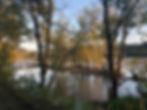Native Plants: Right Plant, Right Place
- Nuts for Natives
- Jan 23, 2020
- 3 min read

“Right plant, right place” advice is everywhere. Since I first began gardening, this always made sense but seemed difficult to follow. How do you know where the right place is for a particular plant? With experience, it becomes somewhat easier but it is still not obvious.
Like you probably do, I read plant tags and profiles of particular plants and go from there. Sometimes, I stretch that information to fit my needs, thinking wouldn’t it be great to have turtlehead (Chelone glabra) blooming in August in this spot …when actually it would have been far better to plant in a moist sunny location as recommended. So, the trial and error method is ok but I wanted more. The more I read, the more I see one should look for where the plant grows in the wild. Since most of my gardening has been in urban or suburban locations, I don’t come across native plants int heir natural settings every day.
This past fall I hit a bonanza. Cycling from Pittsburgh to Washington DC along the Great Allegheny Passage Trail and then through Maryland on the C&O Canal trail, I had hours … and hours … to see native plants growing wild in their natural habitat so I thought I’d share what I observed from the seat of my bike.
There is a lot of goldenrod (solidago) out there growing in sun and shade. It was always, though, seemingly in an area which would get some moisture. This was interesting because goldenrod is frequently described as a fairly tough, drought tolerant plant. Whether it was a trail side ditch or meadow though, it seemed to be in areas that would collect moisture. Flowers were dense in sunny areas and scattered in shade as above right.
Christmas fern (Polystichum acrostichoides) is also prevalent and in the deepest of shade. This is good news for those of us that have tons of shade. If the area is moist, it will grow on rocky outcrops as above left, intermixed with native ginger (Asarum canadense) in the middle and in intense shade above right. Christmas fern is often mentioned as an evergreen ground cover substitute for invasive ivy. It was interesting though that it didn’t appear in massive drifts; it was in smaller colonies.
Gorgeous stands of blue lobelia (Lobelia siphilitica) lined the sunnier wet ditches along side the trail. We saw very few red lobelia (Lobelia cardinalis) but the blue was plentiful. I have never had luck with red lobelia. I don’t know whether the blue is more suited to our area or it is just coincidence.

Speaking of wet conditions, horsetail (Equisetum hyemale) was growing in dense stands in dappled sun and shade in very wet soils. This plant is just as striking in the wild as it is in a modern garden. Please be advised though that this plant really thrives in wet conditions and can be quite vigorous. You may want to experiment in a container first. More and more, horsetail can be found in rain gardens designed to capture stormwater where the garden is completely enclosed by a barrier so it does not spread.

Native Phlox in the Wild
Phlox (Phlox paniculata) appeared from time to time in dappled shade, usually in small clumps. The areas appeared neither wet nor dry, so average moisture.
Many types of aster (Eurybia divaricata) along all parts of the trail are growing in sun, dappled light and shade. The sunnier the spot, the more profuse the flowers. The variety of conditions where aster is growing along the trail speak to how versatile aster is. There are asters for most conditions and in the fall, the flowers were abundant.

Rhododendron Growing Beneath a Deciduous Canopy
Rhododendrons (Rhododendron maximum) grow in huge stands along sections of the trail winding through shady forests of deciduous trees and evergreen hemlocks in Pennsylvania. This made me think of rhododendrons used as foundation plants in some landscapes. That setting seems a far cry from these woodsy forested locations where soils would be very different.
Right plant, right place is something to strive for. Clearly the trees growing on the island in the Potomac at the top of this post seem to have found the right place. As gardeners, we can only keep trying!
For more info:
A detailed report with a list and photos of the best native asters for the mid-Atlantic from the Mt. Cuba Center.
About the Great Allegheny Passage Bike Trail
About the C&O Canal Trail










































